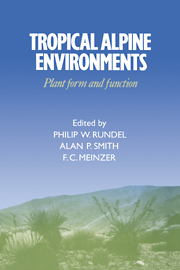Book contents
- Frontmatter
- Contents
- List of contributors
- Preface
- 1 Introduction to tropical alpine vegetation
- 2 Tropical alpine climates
- 3 Páramo microclimate and leaf thermal balance of Andean giant rosette plants
- 4 Comparative water relations of tropical alpine plants
- 5 Cold tolerance in tropical alpine plants
- 6 Anatomy of tropical alpine plants
- 7 Environmental biology of a tropical treeline species, Polylepis sericea
- 8 Morphological and physiological radiation in páramo Draba
- 9 Sediment-based carbon nutrition in tropical alpine Isoetes
- 10 Functional significance of inflorescence pubescence in tropical alpine species of Puya
- 11 Turnover and conservation of nutrients in the pachycaul Senecio keniodendron
- 12 Soil nutrient dynamics in East African alpine ecosystems
- 13 An overview of the reproductive biology of Espeletia (Asteraceae) in the Venezuelan Andes
- 14 Population biology of Mount Kenya lobelias
- 15 Population biology of Senecio keniodendron (Asteraceae), an Afroalpine giant rosette plant
- 16 Population dynamics and flowering in a Hawaiian alpine rosette plant, Argyroxiphium sandwicense
- 17 Plant form and function in alpine New Guinea
- 18 Alpine herbivory on Mount Kenya
- 19 Biotic interactions in Hawaiian high elevation ecosystems
- 20 Tropical alpine ecology: progress and priorities
- Index
17 - Plant form and function in alpine New Guinea
Published online by Cambridge University Press: 21 October 2009
- Frontmatter
- Contents
- List of contributors
- Preface
- 1 Introduction to tropical alpine vegetation
- 2 Tropical alpine climates
- 3 Páramo microclimate and leaf thermal balance of Andean giant rosette plants
- 4 Comparative water relations of tropical alpine plants
- 5 Cold tolerance in tropical alpine plants
- 6 Anatomy of tropical alpine plants
- 7 Environmental biology of a tropical treeline species, Polylepis sericea
- 8 Morphological and physiological radiation in páramo Draba
- 9 Sediment-based carbon nutrition in tropical alpine Isoetes
- 10 Functional significance of inflorescence pubescence in tropical alpine species of Puya
- 11 Turnover and conservation of nutrients in the pachycaul Senecio keniodendron
- 12 Soil nutrient dynamics in East African alpine ecosystems
- 13 An overview of the reproductive biology of Espeletia (Asteraceae) in the Venezuelan Andes
- 14 Population biology of Mount Kenya lobelias
- 15 Population biology of Senecio keniodendron (Asteraceae), an Afroalpine giant rosette plant
- 16 Population dynamics and flowering in a Hawaiian alpine rosette plant, Argyroxiphium sandwicense
- 17 Plant form and function in alpine New Guinea
- 18 Alpine herbivory on Mount Kenya
- 19 Biotic interactions in Hawaiian high elevation ecosystems
- 20 Tropical alpine ecology: progress and priorities
- Index
Summary
Introduction
The tropical alpine environment is surprising. Although it is predictable (Troll 1961; Humboldt, in Botting 1973), it is still remarkable to experience cool, misty mountains that rise out of the lowland tropics. These alpine places bear surprising resemblance in vegetation to the arctic, and to the alpine zones of temperate mountains. They also bear climatic and vegetational resemblance to remote islands of the Southern Ocean. The similarities of vegetation derive primarily from the changes in physical climate that occur as altitude increases on humid mountains. As temperatures decline, different plant species replace those adapted to growth in warmer conditions. The conspicuous changes to vegetation are a transition from tall, tree-dominated communities to low, shrub or herb dominated communities. These transitions occur on a grand scale that has been expressed as a three-dimensional model of climate and vegetation of the earth (Troll 1961; Humboldt, in Botting 1973).
There is controversy about the terms that should be applied to the regions. The argument turns on the degree of recognition given to thermal seasonality, which is weak or absent on the high tropical mountains and profound in the temperate alpine and near polar regions. There are many regional names: alpine, páramos, pahonales, mountain grassland, orosubantarctic, gras maunten, ais, etc. Each has its utility for its own zone – none is without misleading connotations when applied outside its region of origin. In this chapter, the phrase ‘tropical alpine’ is being used to conform to the usage of this book.
- Type
- Chapter
- Information
- Tropical Alpine EnvironmentsPlant Form and Function, pp. 307 - 318Publisher: Cambridge University PressPrint publication year: 1994
- 3
- Cited by



